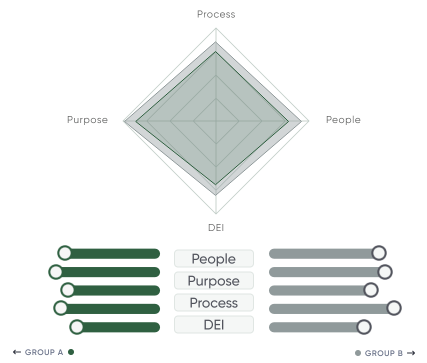Transform Employee Experience Through an Effective Culture Survey

Related Insights
Let’s talk about why you’re here. Maybe your top talent is walking out the door, maybe you’re trying to take your business to the next level, or maybe you’re missing crucial data points to truly understand the needs of your team. Employee experience is a critical factor to organizational success, and measuring it effectively is key to making culture your competitive advantage.
Don’t Let Google Fool You About Employee Experience
What exactly is employee experience? While positive work environment marketing may have us believing it’s the ability to bring your dog to work, ping-pong tables in the breakroom, and sparkling water on tap, the reality is people aren’t joining your company for the beverage options, and they’re not leaving for the lack of billiards. While these ancillary benefits might contribute to a healthy work-life balance, a true measure of employee experience is far more concerned with the work itself. Simply put, employee experience is how someone feels about all of the ways they interact with work.
Factors that influence employee experience could include things like:
- Being able to show up authentically
- The relationship an employee has with a team leader
- The amount of teamwork within their department
- The effectiveness of their onboarding in providing job-relevant training
- The way they connect their role to the goals of the organization
- How they receive and respond to organizational communication
- The ability to influence continuous improvement
At Chapman & Co., we break this into three broad categories: People, Purpose, and Process. In other words, employee experience centers around the human interactions we have at work, the ways we connect to the meaning and impact of our work, and how the work actually gets done.
So, how is employee experience different from culture? If you’ve been around for a while, you probably know what I’m about to say, and if this is your first time here, welcome—it won’t be the first time I’ve said this next line! Culture is the sum of total behaviors. If we add up the totality of employee experiences within your organization, we will have a pretty good understanding of the culture on your team. That is, we impact culture by focusing on employee experience, and therefore we also measure culture by measuring employee experience.
Designing a Culture Survey to Maximize Employee Insights
If you’re looking to better understand the employee experience within your organization, a work culture survey is a powerful tool to establish a data-driven benchmark for your organization moving forward. There are two key components to consider when designing a data collection tool:
1. The What
In the words of Peter Drucker, “What gets measured gets managed,” or, as we like to say (because let’s be honest, no one likes to be managed), “What gets measured gets moved.” If you are looking to elevate your organization’s culture and generate buy-in for doing so, it is critical to consider what you will measure in order to create change.
As a starting place, you may jump to employee satisfaction, employee engagement, or employee well-being as the items you’re looking to measure. While company culture survey questions surrounding these general constructs are important, they are actually centered on the outcome of the experiences your team members are having, as opposed to the experience itself. Questions such as an Employee Net Promoter Score, for example, give us an indication of the engagement level in your organization, but they don’t tell us why employees feel the way they do or how you can impact those survey results. Outcome questions are essential for benchmarking across industries and validating survey data, but they should not be the main focus of your employee survey questions.
Instead, let’s go back to the very definition of employee experience: how someone feels about all the ways they interact with work. The right questions should aim to gather employee feedback on the core areas of their work environment. With a focus on People, Purpose, and Process, you’ll uncover the key components of employee experience and establish metrics that matter to your people, your teams, and your business.
Beginning with the human interactions we have at work, consider questions centered around leadership and management support, team function and effectiveness, and individual care and sense of belonging. Understand how team members interpret the meaning and impact of their work by asking questions related to your company’s core values, individual growth and development opportunities, and employees’ perceptions of the impact of their work to customers and communities. Finally, capture honest feedback related to how the work gets done by assessing communication channels, continuous improvement efforts, and collaboration opportunities.
2. The How
The content of your employee engagement survey is critical, but of nearly equal importance is how you ask the questions. There are three main question types to consider for an organizational culture survey: Likert scale, multiple choice, and open-ended. To best understand the different use cases and outcomes of each of these, let’s apply a real-world example.
A Likert scale question leverages a rating system from Strongly Disagree to Strongly Agree to understand employee sentiments around a specific item. For example:
I have the opportunity to learn the skills I need to do my job.
Based on the level of agreement in the responses, your leaders can be better informed on how team members perceive the continued learning and development opportunities available to them. Likert scale questions are beneficial in providing quantitative sentiment data across your organization. However, they do not always provide the underlying cause behind an employee experience. In this case, if a team member disagrees, you may discover a gap in understanding what opportunities or skills they need that they are not getting.
A multiple-choice question allows employees to select from several options in response to a question. An example might be:
When considering continued learning opportunities, which do you prefer?
- Lunch & Learns
- Self-Guided Virtual Training
- Instructor-Led Virtual Training
- In-Person Training
- Conferences
Multiple-choice questions hone in on the options-based information we often need for decision-making purposes. With this example, we are trying to learn which style of learning opportunities will be most utilized according to our team members’ preferences. In contrast with the Likert scale, this question will not tell us how team members feel about current professional development opportunities.
Open-ended questions give your team members space to respond in their own words. This could look like:
What job-related learning opportunities would you be interested in?
Open-ended questions provide specific details about each team member’s unique experience. Here, we get an in-depth understanding of the exact development resources our team members are looking for, such as communication templates, leadership trainings, or even book recommendations. Depending on what opinions team members choose to voice, there may or may not be an identifiable sentiment around their response. While open-ended survey responses provide a great deal of information to your organization, they may be highly variable and thus leave your leaders spinning on how to create an action plan. (What do we do with 100+ ideas for training opportunities?)
No single type of culture survey question is better than another; rather, they each play a role in how we quantify the employee experience to focus our efforts, gather information for decision-making, and glean valuable insights using real team member perspectives.
By focusing your design efforts on the impact you want to have on your employee experience, both in terms of what you measure and how you measure it, your next culture survey will maximize employee insights in order to drive a strong company culture.
Get Specific About Transforming Company Culture
Describing culture as the sum of total behaviors (I said you’d hear it again) is much like describing the ocean as blue. It provides an accurate and holistic view of the state of the ocean, but it may not allow for the appropriate response depending on which ocean I’m dealing with. Should I bring my sunscreen for the bright turquoise shades of the Mediterranean, or am I preparing to see icebergs in the deep navy hues of the Arctic?
This is where employee demographics play a valuable role. Including demographic information within a workplace culture survey enables you to segment employee experiences so that you can view how the sum of employee experiences varies based on different factors. What are the discrepancies in job satisfaction across teams, departments, sites or countries? How might we investigate the cultural elements that are driving retention and work-life balance across different roles? Are we living out our company values in a way that includes all employees, regardless of their identities? With the necessary demographic information, you can drill down into each of these questions and tailor initiatives to respond accordingly.
Though the benefits of demographic segmentation are numerous, taking a deep dive into the ocean does come with one precursor: preserve anonymity. If employees feel that their responses can be traced back to them individually, you will jeopardize the psychological safety of your team and risk a low response rate or inaccurate feedback. There are two primary ways to protect against this risk. The first is leveraging a third-party survey provider so that no one in your organization will have access to any individual responses. The second is a minimum-response threshold, which requires that each data split or demographic category receives a certain number of responses in order to appear in the survey results report. This ensures responses are grouped adequately to preserve individual anonymity.
Employee Experience: The Bottom Line
Employee experience has the potential to make a positive impact on your company’s productivity, innovation, customer satisfaction, and more. By leveraging an organizational culture survey effectively, you’ll be able to invest in your most valuable resources to create meaningful progress in building a positive company culture and drive business success into the future.
Ready to move beyond basic satisfaction questionnaires? Let's uncover how well your employee experience aligns with your organization's stated values. Contact us today to measure your workplace culture.







